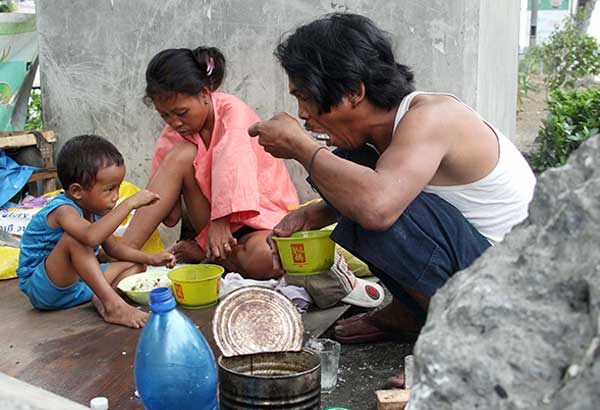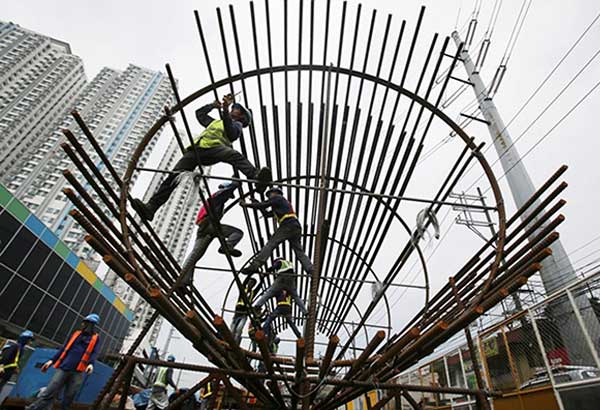Infra, industry reforms at forefront of economic change

Pernia
MANILA, Philippines - As the Duterte administration caps its first full year, reforms geared toward easing foreign ownership restrictions in select industries and fast-tracking the pace of infrastructure development will be prioritized in the next few years.
As far as socioeconomic planning is concerned, the first year was spent on administrative reforms such as streamlining the process for project approvals and assembling bodies – such as the National Economic and Development Authority (NEDA) board – with greater regularity and frequency.
“It’s an institutional reform, the way we approved projects is much faster than previous administrations and we have also streamlined the processes,”said Socioeconomic Planning Secretary Ernesto Pernia in a recent interview.
Alongside the speed at which projects were approved was the shift in project financing preference to the use of official development assistance (ODA) loans and borrowings from multilateral development banks (MDBs) such as the Asian Development Bank (ADB), World Bank and the relatively new Asian Infrastructure Investment Bank (AIIB).
This was, however, met with mixed reactions as several projects were pulled out of the public-private partnership (PPP) pipeline, therefore reducing project opportunities for local builders.
This also raised concerns on the amount of debt the government will accumulate over the course of the administration’s P8.44-trillion spending program that will usher in the so-called golden age of infrastructure.
Economic managers, however, have repeatedly assured the government will use its own funds for 66 percent of the total infrastructure investment requirement under the 2017-2022 Public Investment Program.
On the macroeconomy side, concerns were raised on the adequacy of skilled labor in the country and the possibility of needing to import foreign labor based on need and conditions set forth by the country providing the financing. No conditions for the provisions of loans have been laid down by ODA-providing countries so far.
With this scheme, the government wants to implement financing and hybrid implementation of big-ticket infrastructure projects. Under the first, ODA loan proceeds that bear concessional rates will be mixed with government counterpart funding and loan proceeds with MDBs. Under the second scheme, the government will build the hard infrastructure while the operations and maintenance component would be bid out to the private sector.
To appease the private sector, the government, through the Public-Private Partnership (PPP) Center is promoting the use of the PPP mode of procurement in carrying out projects in local government units.
Now that projects are approved at a faster rate and the shift in financing mode has been settled, the government is setting its sights on carrying out economic reforms that require legislative action.
There are several bills dealing with easing restrictions on foreign direct investment in several industries. Of special interest is the bill filed at the House of Representatives seeking to amend the statutory definitions of public utility in the Public Services Act to open industries like telecommunications, transport, power and water to increased foreign ownership.
President Duterte prefers the imposition of a 70 percent foreign ownership cap in public utilities to spur competition among players and ultimately improve the provision of services at competitive prices, said Pernia.
“The priority bills include the easing of constitutional restrictions (on foreign direct investment) and also the reduction of the negative list. There’s a move to revise the Public Services Act so that utilities like telcos can be redefined so that they will not be in the negative list,” he added.
Through legislation, the administration will also seek to prohibit lower courts from issuing temporary restraining orders (TROs) on the implementation of priority infrastructure projects to hasten their implementation.
“Other efforts have to do with infrastructure projects, projects that are of national significance will not be exposed to TROs except from the Supreme Court, so lower courts will not be able to issue TROs,” Pernia said.
The amendment to the Public Services Act is among the priority pieces of legislation approved recently by the Legislative-Executive Development Advisory Council – Executive Committee (LEDAC-ExCom).
Another is the National Transport Act that contains the National Transport Policy which will harmonize the decisions and investments of transport-related agencies and strengthen coordination between the national and local levels.
Beyond infra
Infrastructure development may be at the forefront of economic reforms under the Duterte administration but not to be set aside are policy changes related to food supply and prices.
LEDAC-ExCom recently certified as urgent a bill liberalizing rice trade in the country through tariffication.
A bill amending the Agricultural Tariffication Act of 1996 is on top of the list of priority measures that will be endorsed by the executive committee for adoption in the next LEDAC meeting and subsequent approval by the President.
Pernia said the rice tariffication bill needs to be passed immediately to prevent trade backlash by member states of the World Trade Organization (WTO) following the three-year extension of the quantitative restriction (QR) on rice imports that entails restricting the volume of inbound rice shipments to 805,200 metric tons (MT) at 35 percent tariff.
While the tariffication bill is passing through the legislative mill, the Philippines may be compelled to extend trade concessions or several products to appease WTO member countries that may be affected by the extension.
NEDA has long been pushing for the liberalization of rice trade in the country with the goal of stabilizing supply and driving down prices.
The other bills identified as urgent during the July 13 meeting of the LEDAC-ExCom were: Unified National Identification System Act, Security of Tenure Bill (End of Endo/Contractualization), Utilization of the Coconut Levy Fund, Budget Reform Act, National Land Use Act, Rightsizing of the National Government, Amendments to the Anti-Cybercrime Act, Amendments to the NIA Charter RE: Free Irrigation Act, Amendment to Public Service Act, Ease of Doing Business Act/Fast Business Permit Act, Government Procurement Reform Act Amendments and the Tax Reform bill.
By identifying these bills as urgent, the administration wants these passed into law within the year, said Pernia.
Philippine Development Plan
The first year of the new administration also saw the completion of the new six-year development plan that aims to transform the country into an upper middle-income economy by 2022 through rapid poverty reduction in rural areas.
Beginning June, Malacanang ordered all government agencies and local government units to align their respective programs and budgets with the Philippine Development Plan (PDP) and Public Investment Program (PIP) for 2017-2022.
The new PDP is the first medium term development plan to be aligned with a long-term vision- contained in Ambisyon Natin 2040 – of attaining inclusive economic growth in the country and eventually transforming the Philippines into a knowledge economy through increased innovation.
It has 21 chapters containing strategies for laying down the foundation for inclusive growth, a high trust society and a globally competitive economy.
By 2022, the Philippines is envisioned to become an upper middle-income economy, growing seven to eight percent annually.
 The Duterte administration is aiming to pull nine million Filipinos out of poverty and keep the country in the growth path by strengthening the agriculture and manufacturing sectors.
The Duterte administration is aiming to pull nine million Filipinos out of poverty and keep the country in the growth path by strengthening the agriculture and manufacturing sectors.Overall poverty rate is targeted to decline from 21.6 percent in 2015 to 14 percent by 2022. Poverty incidence in rural areas is targeted to decrease from 30 percent in 2015 to 20 percent in 2022.
The government wants to cut down unemployment from 5.5 percent in 2016 to 3.5 percent by 2022.
In line with the government’s poverty reduction, Pernia stressed the importance of controlling the rapid growth of the country’s population.
NEDA is currently in the process of coordinating with local government units in localizing the goals under the PDP.
Among the recently-completed regional development plans is that of Northern Mindanao (Region X) which remains optimistic of the prospects of manufacturing, trade, agriculture and forestry even as martial law remains in effect in the entire Mindanao and war against terror continues to be waged in Marawi City.
Northern Mindanao comprises Bukidnon, Camiguin, Lanao del Norte, Iligan City, Misamis Occidental, Misamis Oriental, and Cagayan de Oro City.
During the recently-held launch of the regional plan, Pernia said the region is in a good position to attain this goal in the medium term as it already hosts activities in manufacturing, trade, agriculture and forestry.
The region contributes an average four percent to gross domestic product (GDP) and 26 percent of Mindanao’s GDP. It also has the highest contribution to agriculture sector in Mindanao and is the second highest contributor to the growth of the services sector in the region.
Its regional center, Cagayan de Oro, is expected to become the fourth largest metropolitan center by 2025 – even surpassing growth of Metro Davao – because of projected population growth and its principal role as the principal gateway and trans-shipment hub in the region. The city also remains as the educational center in the region.
The region, said Pernia, also has a huge potential for growing export commodities such as banana, rubber, cacao, coco coir and coffee.
Northern Mindanao’s RDP entails the development of four Strategic Development Areas (SDAs). These are the Cagayan-Iligan Industrial and Trade Corridor (SDA1); Agri-Fishery and Eco-Cultural Tourism area of Lanao and Misamis (SDA 2); Agribusiness Ventures area in Bukidnon (SDA 3); and Ecotourism Adventure Loop in Camiguin (SDA 4).
NEDA Region X director Leon Dacanay. Jr. said agriculture and manufacturing are expected to become the major drivers in Northern Mindanao in the medium term.
“Sixty percent of the output in Mindanao is coming from two regions: Davao and Northern Mindanao. Manufacturing is also a dominant player, and we’re looking at it as a major driver,” he said.
So much so that the possibility of reviving the steel industry is becoming a prospect in the medium term.
“For now, we’re studying the possibility of reviving the steel industry. If we are successful in that, then we can attract upstream and downstream industries that can be situated in various areas in the Cagayan-Iligan industrial and trade corridor,” said Dacanay.
Studies are ongoing for the creation of a roadmap for the revival of the steel industry, he said.
 Construction workers arrange metal rods at a government road project. AP
Construction workers arrange metal rods at a government road project. AP“The studies are now ongoing and we’re trying to look at the steel roadmap. It’s still a proposal, but the R&D (research and development) funds coming from NEDA are already approved, and we’re just about to resubmit the terms of reference so we can start the study. But we’ll conduct it this year,” said Dacanay.
Despite the proximity of the region to Marawi where government troops are waging war against terrorists, Dacanay said the economic activities in the region would not be disrupted.
In fact, the region even stands to gain from the shift in the value chain as buyers shift to sourcing raw materials for processing from Marawi to provinces in the region.
“This is also an opportunity for Northern Mindanao because rather than investments going to Marawi, it will go to Northern Mindanao,” he said.
Martial law, Marawi rehabilitation
Congress on Saturday voted to extended military rule in Mindanao until Dec. 31.
Pernia said the extension of martial rule in the island would prevent the occurrence of uprisings in other regions and ensure the uninterrupted rehabilitation of and reconstruction of Marawi.
The extended martial law is seen to have no significant impact on the country’s medium-term socioeconomic development plan as a whole and even on a regional basis in the case of regions situated near the center of conflict.
“I don’t think there will be a consequential disruption of businesses in Mindanao. Life seems to be going quite normal even in Cagayan de Oro which is quite close to Marawi. It doesn’t seem to be affected by what is going on there. It’s business as usual, really. So in fact martial law is also an environment that will make people feel safe going about their business. So it’s not really a hindrance. It’s more of ensuring that their lives and businesses are not in danger,” said Pernia.
NEDA is already conducting an assessment of the extent of damage in Marawi to determine the cost of rehabilitation. NEDA Undersecretary Adoracion Navarro has been dispatched to the war-torn city to attend meetings on rehabilitation and reconstruction needs.
“We have to carefully cost everything that has been brought to the ground by the fighting. There is a lot of measurement to be done,” he said.
Various development partners, he said, have committed to provide assistance for humanitarian relief and rehabilitation works in Marawi. These countries include Australia, Japan, China and the European Union.
Pernia said earlier that multilateral development institutions World Bank (WB) and Asian Development Bank (ADB) have offered to provide loans and technical assistance for the rapid rehabilitation and reconstruction of Marawi.
- Latest
- Trending





















